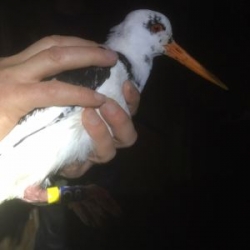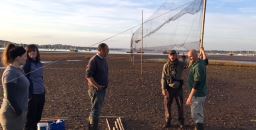Mist netting - Dawlish Warren - Friday 4 October 2019
High Tide 3.40m @ 22:10, Sunset 18:46
After the first two mist-netting sessions of the 2019/20 winter season were cancelled either due to weather or team availability, the group were keen to get out for the next session on the 4th October. Our successful Oystercatcher cannon-net catch on the 28th September had got the ball rolling on deploying the 2019 batch of Oystercatcher GPS-UHF tags, but as we did not catch a single juvenile bird of the 10 desired, this became our target for the evenings mist-netting.
The team of seven assembled before dark to set our nets around the island Oystercatcher roost at Dawlish Warren. The team included several regular attendees alongside new member Thomas Weston and one of our key colour-ring readers, Lee Collins. Once the nets were set, we waited for the tide to rise and bring to birds to roost.
Unfortunately, in terms of numbers the session was almost a blank, most likely due to the high level of ambient artificial light in the estuary that evening and moderate wind making the mist-nets more visible than desired. Fortunately, two positive events occurred, the first is that some of the team members managed to sneak off and bring back fish and chips, the second and far more important, is that the one bird caught was a juvenile Oystercatcher. Ryan Burrell, DCWRG Projects Officer, fitted this bird with a GPS-UHF tag, taking our 2019 sample to 11 (10 adults/sub-adults and 1 juvenile) allowing us to follow its progress, movements and site use over the next few years.
Thanks as always go to all those involved from DCWRG and Teignbridge Council and Warren Golf Club for their on-going support of DCWRG projects.
| Species | Ringed | Retraps | Controls | Colour ringed | GPS tagged |
|---|---|---|---|---|---|
| Oystercatcher | 1 | 0 | 0 | 1 | 0 |
Mist-netting - Dawlish Warren - Monday 29 October 2018
 Leucistic Oystercatcher ringed on 29 Oct 2018We had the second mist netting session at Dawlish Warren on 29 October 2018, with a team of 11. We had hoped we would catch more than the 8 Oystercatchers and 3 Dunlin that we managed, as we set 10 nets on three sides of the island roost. A ship in the estuary with bright lights made the nets visible which may have been a factor. Nevertheless, it was worthwhile as Andrew Hoodless was able to check measurements for the harness for the GPS tags we plan to fit to Oystercatchers in the future to study their day-to-day movements.
Leucistic Oystercatcher ringed on 29 Oct 2018We had the second mist netting session at Dawlish Warren on 29 October 2018, with a team of 11. We had hoped we would catch more than the 8 Oystercatchers and 3 Dunlin that we managed, as we set 10 nets on three sides of the island roost. A ship in the estuary with bright lights made the nets visible which may have been a factor. Nevertheless, it was worthwhile as Andrew Hoodless was able to check measurements for the harness for the GPS tags we plan to fit to Oystercatchers in the future to study their day-to-day movements.
One of the oystercatchers was very interesting, and one a few of us have seen around the Exe in the last couple of years – a leucistic bird with almost a completely white head. Thanks to all that helped – especially as some had a long journey home afterwards.
| Species | Ringed | Retraps | Controls | Colour ringed | GPS tagged |
|---|---|---|---|---|---|
| Oystercatcher | 8 | 0 | 0 | 8 | 0 |
| Dunlin | 3 | 0 | 0 | 0 | 0 |
Mist-netting - Dawlish Warren - Saturday 29 Sep 2018
High Tide 3.70m
On the evening of 29 September 2018 at Dawlish Warren a team of 14 took a modest mist-net catch of 13 Oystercatcher (10 new birds and 3 retraps) and a Dunlin, but it was good to get a session under our belts. We colour-ringed another 12 birds, and was great to see that one of the retraps was ringed over 24 years ago - more details here. We learnt a lot from our first session, and feel like we can build on this and will catch a lot more in the future. The 3.7m tide was fine in the conditions we may chose lower tides in future and set more nets.
Huge thanks to Steve and the ranger team for all the help and support, particularly for providing so many of the team with chest waders. It was also great to have the Golf Club being so helpful and allowing us to drive the land rover down their track – that made life so much easier than having to carry all that kit.
| Species | Ringed | Retraps | Controls | Colour ringed | GPS tagged |
|---|---|---|---|---|---|
| Oystercatcher | 13 | 0 | 0 | 12 | 0 |
| Dunlin | 1 | 0 | 0 | 0 | 0 |
Page 4 of 4
- Latest
- More recent
- 1
- 2
- 3
- 4
- Older
- Oldest
Mist-netting Background
The use of mist-nets on high tides during the hours of darkness is less selective in which species are caught, but this technique provides us with additional opportunities to catch and ring waders in the region. A mist-net catch can usually be managed with a smaller team and without the need for a specialist cannon net license holder or the preparatory work needed to reconnaisace precise roost sites and set cannon nets in advance of the planned catch tide.
Our focus on the Exe estuary is the wintering Oystercatcher population and this species is our primary target for mist-netting as we aim to catch birds flying into the high-tide roosts.
Oystercatchers are faithful to wintering sites so the birds you have seen here years ago may be the same ones now. The oldest Dawlish Warren Oystercatcher on record is at least 36 years old, last seen in Jan 2018.
If you see a bird with one of our colour rings, please use the form on this website to send us the details (ring-code, date, location, species) or you can send email to This email address is being protected from spambots. You need JavaScript enabled to view it..
Mist-netting totals
2018-2019 winter totals
| Species | Ringed | Retraps | Controls | Colour ringed |
|---|---|---|---|---|
| Oystercatcher | 21 | 0 | 0 | 20 |
| Dunlin | 4 | 0 | 0 | 0 |
2019-2020 winter totals
| Species | Ringed | Retraps | Controls | Colour ringed |
|---|---|---|---|---|
| Oystercatcher | 1 | 0 | 0 | 1 |
Grand totals
| Species | Ringed | Retraps | Controls | Colour ringed |
|---|---|---|---|---|
| Oystercatcher | 22 | 0 | 0 | 21 |
| Dunlin | 4 | 0 | 0 | 0 |
